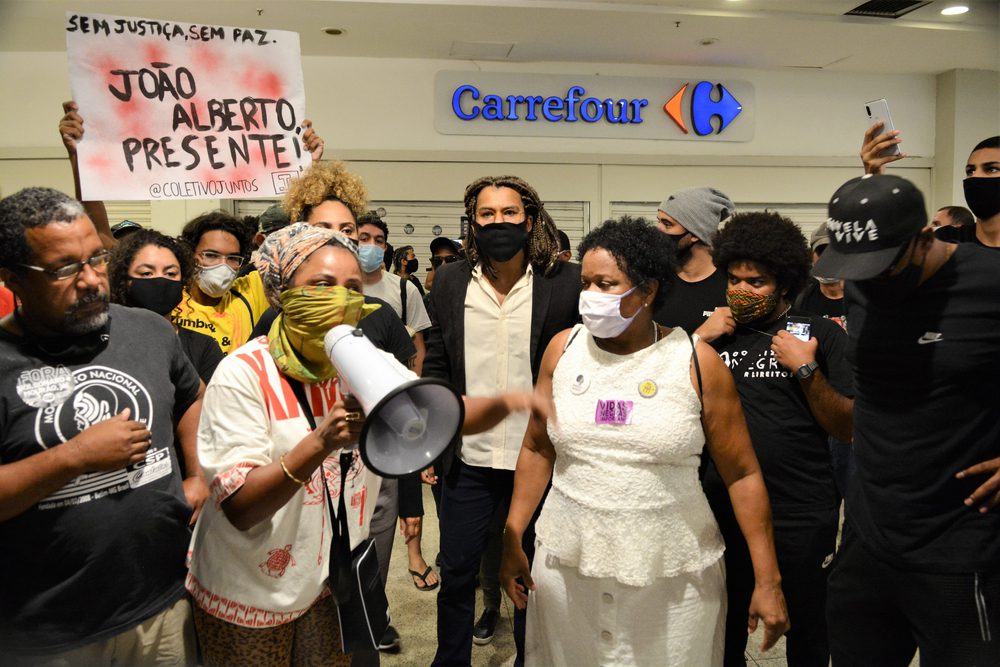Afro-Brazilians’ Antiracist Media Productions
This post is part of our online roundtable on Reighan Gillam’s Visualizing Black Lives.

Who gets to imagine and visualize Black Lives? In Brazil, the white dominance of mass media and other sectors has historically delimited and confined Black representation. Yet, social movements, identity formation, and visual cultures work together to re-envision freedom. Reighan Gillam’s Visualizing Black Lives: Ownership and Control in Afro-Brazilian Media illustrates how Afro-Brazilian media producers endeavor to transform Black representation and narrative and thereby, portray Black humanity and inclusion in Brazil. Gillam’s study of media producers and media texts illuminates racial dynamics in Brazil and confronts the persistent denial of racism in the public sphere. Using a wide range of texts, from YouTube series to documentary films to graffiti art, Gillam persuasively argues that Afro-Brazilian media texts cultivate what Gillam terms antiracist visual politics to identify and disrupt racist ideologies and practices. Visualizing Black Lives demonstrates the significance of Afro-Brazilian media producers taking control over their own images.
Visualizing Black Lives is aptly named given the significance of global Black Lives Matter movements in producing forms of Black subjecthood. The book makes the case for why Afro-Brazilian movements take up visual production as a means of shaping meanings and knowledge of Black identities. The book weaves how Afro-Brazilian movements, legislation such as Law no. 10.639 requiring the teaching of Afro-Brazilian history and culture in schools, and media representation and production work in conjunction to advance racial justice. Furthermore, the book demonstrates how Afro-Brazilian activists strategically intervene in their own representation through lawsuits, navigating white-dominated media industries, and the creation of independent media.
While other scholarly work examines the limited representation of Afro-Brazilians in mass media, Visualizing Black Lives examines the alternative mediascapes of independent Afro-Brazilian production. By eschewing the dominance of media corporations such as Globo, Gillam’s focus becomes less of a study of gradations of racial progress. Instead, Visualizing Black Lives focuses on Afro-Brazilian radical imagination and ingenuity. Gillam’s media producers offer counternarratives to the ways in which Blackness is presented as a problem in Brazil or as an object of ridicule with the simultaneous downplaying of racism.
With a focus on Afro-Brazilian directors, producers, writers, and actors of YouTube series, Gillam’s subjects address the questions of how and why are Afro Brazilian communities erased or marginalized in cultural productions and how are Afro Brazilian bodies constructed as disposable. Gillam’s chapter on TV Gente, a Black independent television station, acts as a springboard to discuss Brazilian racial inequities in both production and representation. While dominant mass media like TV Globo deals with the reproduction and revaluation of white identity as the default standard and as a lucrative commercial engine, TV Gente works on the production of Black identity as its programming focus. TV Gente’s focuses on Black identity as a source of empowerment. TV Gente offers the opportunity for televisual representations that resonate with Black audiences. The Afro-Brazilian media producers reject the white imagination of Black racial meanings.
Alongside the focus on Afro-Brazilian media production, Visualizing Black Lives contributes to intersectional understandings of race, gender, and class. Gillam’s textual analysis of two fictional films, Cores e Botas and Jennifer lays out how whiteness has functioned as the norm and then finds spaces of resistance to reaffirm Black identification and pride. Gillam’s focus on gender dynamics is particularly useful in underlining how white femininity shapes standards of beauty. In particular, Jennifer refuses the circulating discourses that encourage whitening or disidentification from Blackness. The comments from interviews with TV Gente producers and films such as Cores and Botas and Jennifer reflect the consensus of how Blackness is situated in opposition to beauty. The intertwined racial logics of whitening and racial democracy dictate a confirmation to an approximation of whiteness as explored through hair in the two films. The dream of upward social status through beauty and whitening is evident in both films as the two girls featured attempt to aesthetically change their appearance in the hopes of self-fashioning towards whiteness. Instead of beauty being presented as individual sites of empowerment and the opening up of opportunities, the films reposition the white standards of beauty as collective trauma. These films then give agency to the female protagonists that they can employ to reject hegemonic white beauty norms.
Gillam’s expansion of media texts and media producers that include Afro-Brazilian middle classes also dispels myths that classism and not racism is a major problem in Brazil. Gillam’s range of middle-class media makers and media texts centering on Afro-Brazilian middle-class lives demonstrate that class status does not necessarily translate into respectability or privileges of whiteness. Furthermore, the Afro-Brazilian media makers seek to deepen connections with Blackness rather than a distancing of Black identification which runs contrary to the Brazilian saying of “money whitens.”
Visualizing Black Lives situates Afro-Brazilian media with the cultivation and distribution of new kinds of articulations and mobilizations of Blackness. With US digital activism such as #oscarssowhite and calls for larger Black representation and production, Visualizing Black Lives places the need for Black control over their own narratives in a diasporic context. If the movement for Black Lives is a global struggle, then the envisioning of Black subjecthood is also a transnational diasporic formation.
Copyright © AAIHS. May not be reprinted without permission.